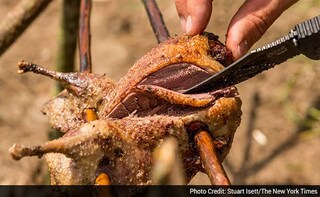When I was a 10-year-old kid in western Michigan, I discovered Sydney Pollack’s melancholic “Jeremiah Johnson.” The film chronicles the misadventures of a disillusioned mountain man (Robert Redford) who wanders the Rockies in the mid-1800s.
Apple, cherry, alder, mesquite and oak are good choices. You’re cooking with embers more than direct flame, so let the fire burn down for a half-hour or so before you start cooking. It’s smart to build an auxiliary fire off to the side from which you can draw additional coals as needed.3. As the fire burns down, spatchcock the bird by splitting it up the spine and opening it like a book. This decreases cooking time considerably and reduces the number of surfaces that need to be exposed to heat. With larger birds, such as chickens, you can split the bird in half by cutting through the breast bone as well.4. Sprinkle the bird with coarse salt and rub it in. Then place your skewers, careful to run them crosswise through the thickest parts of the bird to support it.5. Build the rack by driving the four forked sticks into the ground. The exact height of the rack is not as important as the amount of heat the meat receives. It should rest in a position where you can hold your hand for three or four seconds before you have to pull it away, usually about 18 inches high.6. Balance the two horizontal supports, parallel to each other, on top of the forked vertical supports.7. Place the bird above the embers, with the skewers balanced on the horizontal supports. Monitor it closely. Flip often to avoid charring, and adjust heat by positioning embers beneath the meat or pushing them away. Cook times will vary with the size of the bird, quality of the fuel, weather, etc.8. Duck should be cooked to an internal temperature of 135 degrees, which will take 40 minutes perhaps. Cook chicken to 160 degrees, which may take an hour for a half-bird and even longer for a whole bird.© 2015 New York Times News Service
Advertisement
Advertisement
Apple, cherry, alder, mesquite and oak are good choices. You’re cooking with embers more than direct flame, so let the fire burn down for a half-hour or so before you start cooking. It’s smart to build an auxiliary fire off to the side from which you can draw additional coals as needed.3. As the fire burns down, spatchcock the bird by splitting it up the spine and opening it like a book. This decreases cooking time considerably and reduces the number of surfaces that need to be exposed to heat. With larger birds, such as chickens, you can split the bird in half by cutting through the breast bone as well.4. Sprinkle the bird with coarse salt and rub it in. Then place your skewers, careful to run them crosswise through the thickest parts of the bird to support it.5. Build the rack by driving the four forked sticks into the ground. The exact height of the rack is not as important as the amount of heat the meat receives. It should rest in a position where you can hold your hand for three or four seconds before you have to pull it away, usually about 18 inches high.
Advertisement
For the latest food news, health tips and recipes, like us on Facebook or follow us on Twitter and YouTube.
Advertisement
